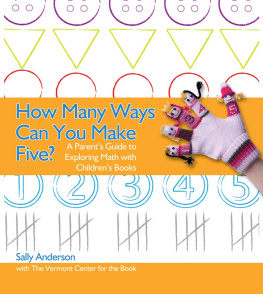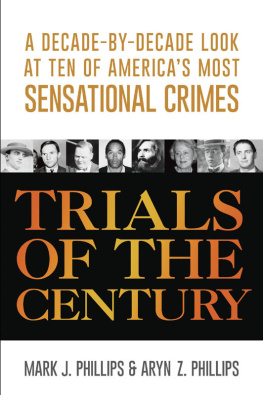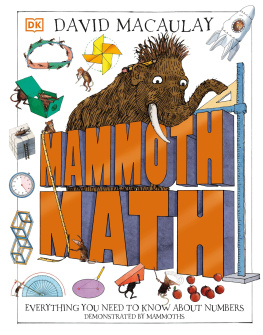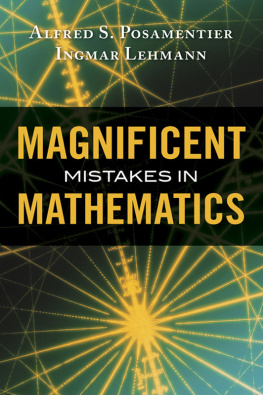MATH ON TRIAL
MATH ON TRIAL
How Numbers Get Used and Abused
in the Courtroom
Leila Schneps and
Coralie Colmez
BASIC BOOKS
A Member of the Perseus Books Group New York
Copyright 2013 by Leila Schneps and Coralie Colmez
Published by Basic Books, A Member of the Perseus Books Group
All rights reserved. No part of this book may be reproduced in any manner whatsoever without written permission except in the case of brief quotations embodied in critical articles and reviews. For information, address Basic Books, 250 West 57th Street, 15th Floor, New York, NY 10107-1307.
Books published by Basic Books are available at special discounts for bulk purchases in the United States by corporations, institutions, and other organizations. For more information, please contact the Special Markets Department at the Perseus Books Group, 2300 Chestnut Street, Suite 200, Philadelphia, PA 19103, or call (800) 810-4145, ext. 5000, or e-mail .
Designed by Jeff Williams
Library of Congress Cataloging-in-Publication Data
Schneps, Leila.
Math on trial : how numbers get used and abused in the courtroom / Leila Schneps and Coralie Colmez.
pages cm
Includes bibliographical references and index.
ISBN 978-0-465-03794-0 (e-book)
1. Forensic statistics. I. Colmez, Coralie, 1988 II. Title.
K2290.S73S36 2013
345'.07dc23
2012040624
10 9 8 7 6 5 4 3 2 1
We dedicate this book to all those who have suffered from miscarriages of justice, and to all victims of crimes whose perpetrators went unpunished, due to the misuse or misunderstanding of mathematics in the legal process.
CONTENTS
Everywhere we turn we are assailed by numbers. Advertisements, news, price reductions, medical information, weather forecasts, investment, risk assessment: all this and more is communicated to us through probabilities and statistics. But the problem is that these figures are not always used to convey information. As often as not, they are used to give us spin: to influence, frighten, and mislead us with the cool authority of numbers and formulas.
Now, you might think this a trivial matter. You may be one of those people who skip past the numbers in the articles you read, who pay no attention to the declarations of sensational increase or decrease in whatever drama is playing out on the front page, whether it be global warming, shark infestations, or illiteracy. At worst, you think, people are mildly misinformed. But as we show in Math on Trial, the misuse of mathematics can be deadly. The same mathematical tricks that mislead the public about market trends and risk and social problems have sent innocent people to prison. Being wrong about the price of oil is one thing; being denied justice due to miscalculation is quite another.
Despite their ubiquity, however, most of these fallacies are easy to spot. The fact is that anyone can make a decent assessment of mathematical statements that appear in popular publications, on common products, and in everyday activities from investment to DNA analysis. Anyone can acquire the simple reflexes to cut through the fog of mathematical deception. All it takes is a little practice to recognize whats going on. It turns out there isnt much variation in these numerical sleights of hand, but public ignorance allows them to permeate every area of our lives. We have chosen the examples in this book because while illustrating the pitfalls that everyone should be aware of, they also show that the misuse of mathematics is not merely an academic issue that we can easily ignore.
We need to know when we are being misled. We need to be able to distinguish whether the numbers brandished in our faces are legitimately providing information or being misused for dangerous ends. We need to go beyond the abstraction of theory and see the plain truth for ourselves.
Mathematics has made but few appearances in criminal trials throughout history. When it has been used, it has been for purposes of identification, to calculate the probability that a given identification is correct. These same calculations occur in a thousand other domains of public and private life, and one might wonder why we have chosen to focus here on its relatively rare use in trials. We believe it is worth collecting and examining these cases for the simple reason that many of the common mathematical fallacies that pervade the public sphere are perfectly represented by these trials. Thus, they serve as ideal illustrations of these errors and of the drastic consequences that faulty reasoning has on real lives.
The cases we present in this book cover a broad range of mathematics used in the courtroom, from the simplest handwriting analysis at the end of the nineteenth century to probabilities used in DNA identification today. These cases are not ordered chronologically, but according to the complexity of the probability concepts in question. We discuss cases in which mathematics was presented at trial to justify conviction, and others in which it was employed to convince the public that conviction was erroneous.
In spite of mathematics disastrous record of causing judicial error, the main conclusion of our analysis is not that probability is a useless cog in the judicial machine. Rather, we found that the injustices perpetrated in the name of probability arise from the misuse of mathematical principles, not from any inherent inapplicability of mathematics to justice. We believe that mathematics can be useful in fundamental ways, and indeed that the future of criminal justice will necessarily contain an element of mathematical analysis, given the prevalence of DNA evidence in trials today. But to reach that goal there must be some certainty that mathematical errors will be excluded from trials, and the first step in this direction is to identify the most important errors that have actually occurred.
In this book we share the dramas of people who saw their lives ripped apart by simple mathematical errorswrong calculations, or calculations that were not made or not understoodgrave injustices that were committed or only narrowly avoided. We hope that these incredible true stories will show that mathematics can really be a matter of life and death.
MOST PEOPLE KNOW that to measure the probability that several events will occur, the separate probabilities of each event should be multiplied together. For instance, if you are pregnant with a single child, there is a 1 out of 2 chance you will give birth to a girl. Thus if you have two children at different times, the probability of having 2 girls is squared, which is , or 1 chance out of 4.
We do this type of calculation all the time, almost without thinking. But theres a caveat: this multiplication is correct only if the events youre comparing are totally independent from each other, like having separate pregnancies. If they are not independent, the situation changes. Suppose, for example, that you happen to know from an ultrasound that you are pregnant with identical twins. Now the birth of your two children does not constitute two independent events, and of course it would be wrong to say that the probability of your having two girls is ; it is in fact , because the two babies share the same genes, so they will necessarily be of the same sex; thus they can only be either two girls or two boys.
If you multiply the probabilities of events that are not independent of each other, you will get a significantly smaller probability than is accurate. But its easy to fall into the trap of assuming that a set of separate events occurred or will occur independently of one another. Some events may seem independent but have a single underlying cause. For example, a card player may go on a winning streak that defies all oddsbut the reason could be that hes cheating.








